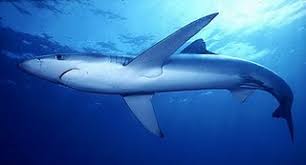Does the tiger shark, known as the tiger shark or blue shark category of near threatened species?
The National Action Plan for the Conservation of Sharks, Stripes and Chimeras, define the tiger shark as a high priority species for the continental Caribbean, this based on four criteria related to fishing, commercialization, distribution and threat category.
The nickname "tiger" is due to the fact that, like the great felino Asian, This shark has a series of dark transverse stripes on its back and sides that tend to fade with age.. Its skin varies from blue to bluish green, which is great camouflage since this shark usually hunts by attacking its prey from below, going unnoticed in the depths..
Its eyes are large and circular and the nostrils are elongated and very forward., arranged almost in a frontal position. The teeth are big, sharp and very pointed, provided with strongly serrated edges, except on the inside of the tip. The body is quite corpulent, can weigh 1524kg.
It is considered that the recorded capture of the species Galeocerdo cuvier is incidental in the Department of La Guajira, The fishing gear and exact location of the record are unknown., Nevertheless, There are already records of the capture of this species in the Department, it is necessary to inform the competent authorities.
































Leave a reply
I am sorry, you should be connected to post a comment.